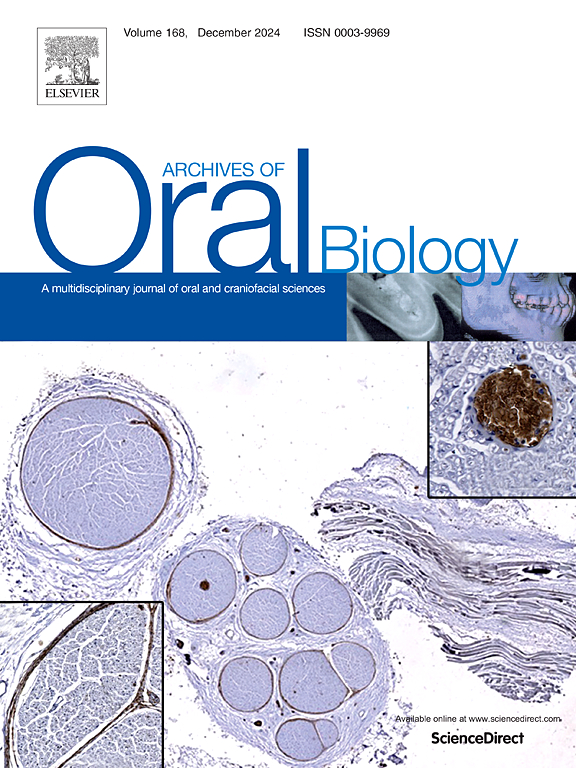Anaphase promoting complex subunit 10 is a potential diagnostic and prognostic biomarker in oral squamous cell carcinoma
IF 2.1
4区 医学
Q2 DENTISTRY, ORAL SURGERY & MEDICINE
引用次数: 0
Abstract
Objective
To explore the role of anaphase promoting complex subunit 10 (ANAPC10) in both the diagnosis and prognosis of oral squamous cell carcinoma (OSCC).
Design
ANAPC10 expressions in OSCC tissues and adjacent normal tissues were analysed using TCGA and GEO databases. Its clinical prognostic significance was evaluated using the GEPIA tool. Signalling pathways associated with ANAPC10 were identified through GO, KEGG, and GSEA. Promoter methylation levels of ANAPC10 were assessed using the UALCAN tool. The correlation between ANAPC10 expression and tumour-infiltrating immune cells was analysed using the TIMER database. ANAPC10’s role in OSCC cells was validated via CCK-8 assays, wound healing assays, cell migration assays, apoptosis assays, and cell cycle analysis.
Results
ANAPC10 expression was significantly elevated in OSCC tissues. Increased ANAPC10 expression was associated with advanced T stages, pathological stages, histologic grades, and poorer therapeutic outcomes. Notably, high ANAPC10 expression was strongly correlated with reduced overall survival, disease-specific survival, and progression-free interval in OSCC patients. Functional enrichment analyses revealed that ANAPC10 is involved in RNA splicing, immune regulation, and cell cycle progression. Experimental validation further demonstrated that ANAPC10 levels are influenced by promoter methylation status, and ANAPC10 regulates oral cancer cell proliferation, migration, apoptosis, and cell cycle progression.
Conclusion
ANAPC10 is a critical gene in OSCC prognosis, with roles in cell cycle regulation and RNA splicing. It may serve as a diagnostic biomarker and therapeutic target.
晚期促进复合体亚基10是口腔鳞状细胞癌潜在的诊断和预后生物标志物
目的探讨晚期促进复合体亚单位10 (ANAPC10)在口腔鳞状细胞癌(OSCC)诊断和预后中的作用。应用TCGA和GEO数据库分析DesignANAPC10在OSCC组织和癌旁正常组织中的表达。使用GEPIA工具评估其临床预后意义。通过GO、KEGG和GSEA鉴定了与ANAPC10相关的信号通路。使用UALCAN工具评估ANAPC10启动子甲基化水平。利用TIMER数据库分析ANAPC10表达与肿瘤浸润性免疫细胞的相关性。通过CCK-8实验、伤口愈合实验、细胞迁移实验、细胞凋亡实验和细胞周期分析验证了ANAPC10在OSCC细胞中的作用。结果sanapc10在OSCC组织中的表达明显升高。ANAPC10表达的增加与晚期T分期、病理分期、组织学分级和较差的治疗结果相关。值得注意的是,高ANAPC10表达与OSCC患者总生存期、疾病特异性生存期和无进展时间缩短密切相关。功能富集分析显示ANAPC10参与RNA剪接、免疫调节和细胞周期进程。实验验证进一步表明,ANAPC10水平受启动子甲基化状态的影响,ANAPC10调控口腔癌细胞的增殖、迁移、凋亡和细胞周期进程。结论anapc10基因参与细胞周期调控和RNA剪接,是影响OSCC预后的关键基因。它可以作为诊断性生物标志物和治疗靶点。
本文章由计算机程序翻译,如有差异,请以英文原文为准。
求助全文
约1分钟内获得全文
求助全文
来源期刊

Archives of oral biology
医学-牙科与口腔外科
CiteScore
5.10
自引率
3.30%
发文量
177
审稿时长
26 days
期刊介绍:
Archives of Oral Biology is an international journal which aims to publish papers of the highest scientific quality in the oral and craniofacial sciences. The journal is particularly interested in research which advances knowledge in the mechanisms of craniofacial development and disease, including:
Cell and molecular biology
Molecular genetics
Immunology
Pathogenesis
Cellular microbiology
Embryology
Syndromology
Forensic dentistry
 求助内容:
求助内容: 应助结果提醒方式:
应助结果提醒方式:


